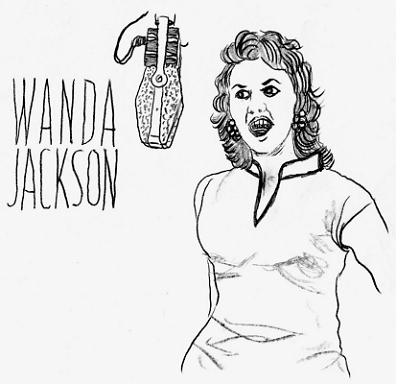
So, ein drittes Mal Wanda Jackson, die irgendwie doch um einiges mehr hergibt als The Grateful Dead. Huch, lassen wir die Gehässigkeit beiseite - Entschuldigung! I don't like the way you touch my baby if you're smart you turn him loose / Unless you crave danger or you're crazy cause this gun don't care who it shoots / You better take your hands off my baby or they're gonna bury you in your boots / Keep what I’m saying for I ain't fooling and this gun don't care who it shoots / This old gun of mine has no conscience shows no favors as never caught the tree / So it's all up to you now pay attention cause this gun don't care who it shoots. Ja, die Sängerinnen, Musikerinnen waren rar im Genre Rockabilly, aber es gab sie und Aimee Murillo hat für uns die Liste "The 10 Best Female Rockabilly Singers Of All Time" zusammengestellt, die wirklich okay ist. Auf Platz 1 findet sich natürlich Wanda Jackson. I'm glad to see you've made a right decision just stuck away you'd better pull up roots / And let's hope that you'll never cross my vision / Cause this gun don't care who it shoots / This old gun of mine / No this gun don't care who it shoots. Platz 2, tatüdada, Rosie Flores. Flores' style of rockabilly merges together the twang of Western swing with Tex-Mex, along with other elements like country, pop and jazz. Rosie Flores begann ihre musikalische Laufbahn in der Cowpunk-Band Screaming Sirens und veröffentlichte 1987 ihr erstes Soloalbum. Ihren bisher größten Erfolg hatte sie mit dem Song "Crying Over You" 1987. Auf Platz 3 ist Janis Martin, known famously as the 'Female Elvis'. Martin started her career in country music and signed with RCA records at the ripe age of fifteen. Ihr erster Hitsong bei RCA Victor Records war "Drugstore Rock’n’Roll" 1956. Platz 4 belegt Kim Lenz. The redheaded Lenz grew up on a wide range of musical influences, from Irving Berlin to New Wave female singers of the '80s, and as the singular female lead for her group The Jaguars, she keeps a roots Americana sound in her brand of rockabilly, along with some influences of Western Swing and Honky Tonk. Kim Lenz ist seit 1996 mit ihrer Band The Jaguars, bestehend aus Tom Umberger (Guitar), Shawn Supra (Bass, Fiddle) und Scotty Tecce (Drums) unterwegs. Kim Lenz spielt selbst Piano und Gitarre. Yeah. Auf Platz 5 findet sich Little Miss Dynamite Brenda Lee und auf Platz 6 Lil Gizzelle. Gizzelle is signed to the Wild Records label from Los Angeles, which promotes lots of newer rockabilly and rock'n'roll artists, many of whom are Latino. Unbedingt anhören sollte man sich von ihr die Songs "Baby Please Don’t Go" 2005 und "I’m A Good Woman" 2010. Auf Platz 7 und Platz 8 finden sich Amber Foxx und Charline Arthur, ein sehr empfehlenswerter Song von Charline Arthur ist "Just Look, Don’t Touch, He’s Mine" 1956, yeah, und Platz 9 und 10 belegen Sparkle Moore und Lorrie Collins, die von 1954 bis 1962 mit ihrem Bruder Larry als The Collins Kids in der Popwelt unterwegs war. Hm, ich würde der Liste von Aimee Murillo noch Rose Maddox hinzufügen, die ja in späten Jahren den Spitznamen "The Grandmother Of Rockabilly" erhielt, yeah, und Debbie Stevens mit ihrem Song "If You Can’t Rock Me" 1959 sollte auch nicht fehlen, huh-huh, und Pat Ferguson mit "Fool I Am" 1960 sowie Jackie Dee alias Jackie De Shannon und Bunny Paul ebenfalls nicht. So, hab sicherlich einige Gute vergessen, naja, was solls. Meine Aussage, die Sängerinnen, Musikerinnen waren rar im Genre Rockabilly, bezieht sich natürlich auf die 50er, 60er Jahre, im Postrockabilly, Punkabilly oder Psychobilly gibt es inzwischen schon einiges an Sängerinnen und Musikerinnen. Ja, Rosie Flores, Kim Lenz, Lil Gizzelle und Amber Foxx, auf der Liste von Aimee Murillo, gehören ja schon zur neuen Billy-Generation, yeah. Der Song "This Gun Don’t Care (Who It Shoots)" ist auf der 2006 bei Ace Records erschienenen CompilationCD "Wanda Jackson: The Very Best Of The Country Years" zu finden. Ja, 1966 war die grosse Zeit des Rockabilly natürlich längst vorbei und Psychedelic Music begann bereits zu blühen. Die war außer einigen wenigen Ausnahmen ausschließlich weiß, die farbigen MusikerInnen fröhnten dem Soul, der eigentlich erst Ende der 60er Jahre eine eigene Psychedelic Strömung hervorbrachte. Bands wie Parliament, Funkadelic, The Chambers Brothers, The Temptations oder Sly & The Family Stone verbanden Soul und Funk mit Psychedelic, yeah, aber dazu kommen wir noch in dieser Liste.